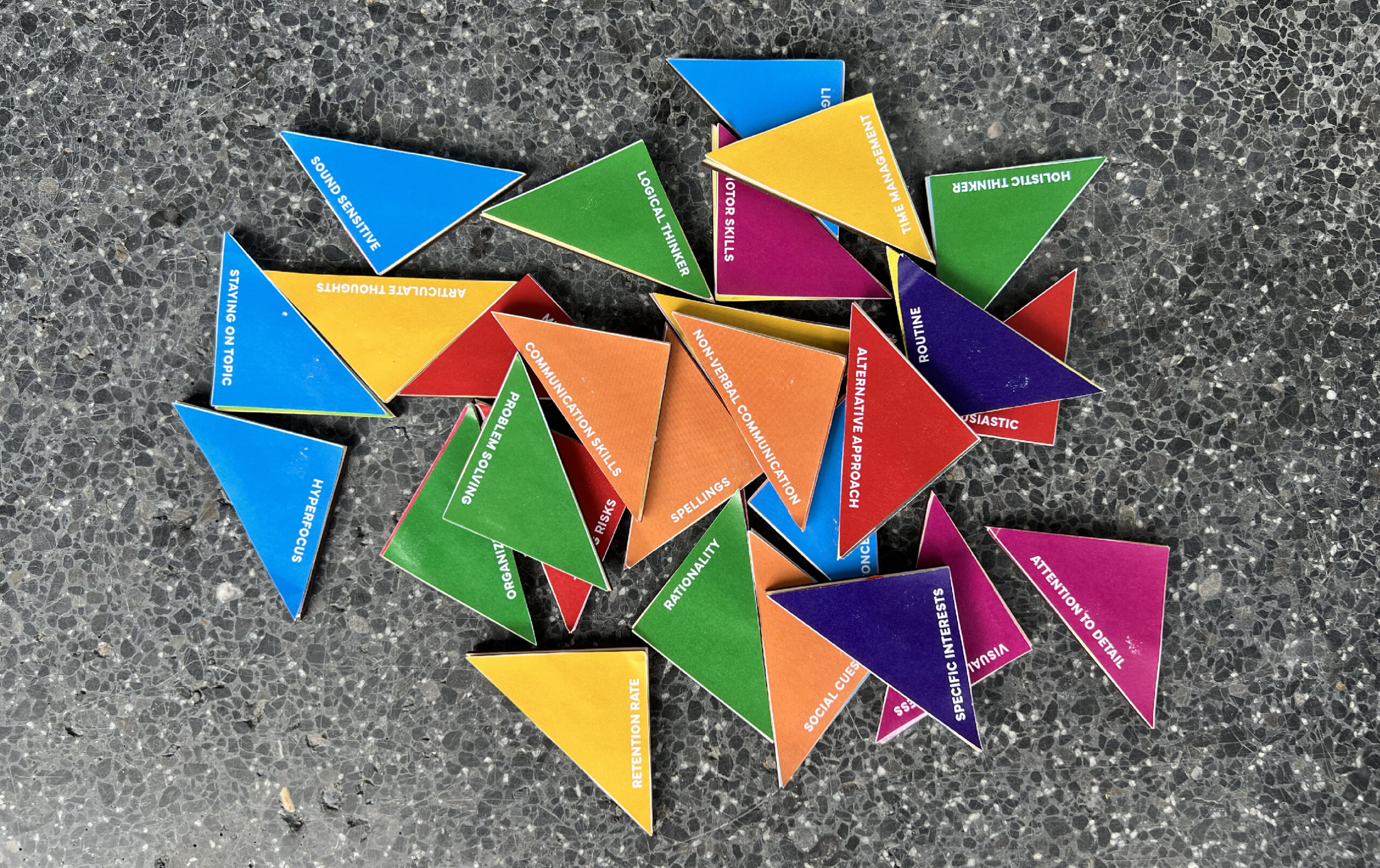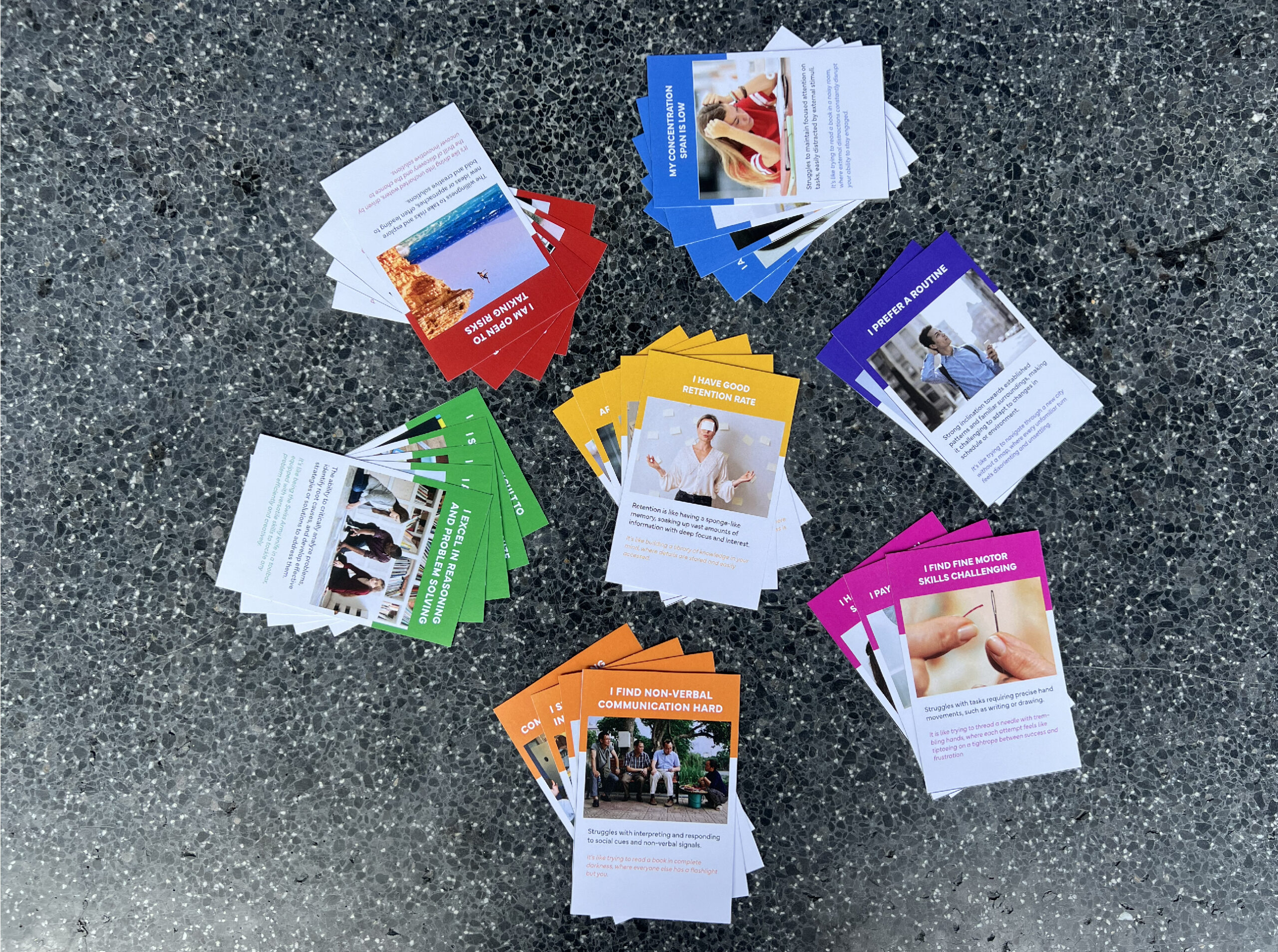By Aayushi Gupta
Introduction
Diversity is essential for innovation in design teams, with studies showing that teams with varied genders, nationalities, and expertise outperform less diverse teams (Page, 2007). These teams benefit from diverse perspectives, experiences, and thinking styles, excelling at problem-solving and generating new ideas (Phillips, 2022). However, while progress has been made in embracing gender and cultural diversity, neurodiversity remains under tapped. Coined by sociologist Judy Singer in the 1990s, neurodiversity acknowledges neurological differences as natural variations, not disorders. Just as biodiversity strengthens ecosystems, neurodiversity enriches society by embracing different ways of processing information and perceiving the world (Miller, 2024).
Recognizing and valuing neurodiverse traits is essential not only for individuals but for creating inclusive environments that benefit everyone. Design teams play a critical role in shaping products and services, and embracing neurodiversity can unlock vast potential for creativity and innovation (Austin, 2021). However, neurodiversity is often overlooked as a form of diversity, presenting both challenges and opportunities. By overcoming biases and embracing the full range of human thinking styles, teams can enhance collaboration, inclusiveness, and overall effectiveness. The project aim was to bridge the gap by encouraging design teams to embrace neurodiversity, ultimately enhancing their effectiveness and inclusiveness leading to better collaboration and innovation.
Approach
What is the current understanding of diversity in design teams?
What strategies have been effective in fostering inclusivity and collaboration in diverse teams?
How does cognitive neurodiversity affect group work?
What are the characteristics (strengths and challenges) of a neurodiverse individual?
How are neurodiverse design teams guided?
To answer the above questions, the approach of this project combined empirical and theoretical research methods. It began with a literature review to build a conceptual foundation, exploring diversity and neurodiversity in design teams. Instead of categorizing neurodiverse individuals by specific conditions (like ADHD, autism, or dyslexia), the project focused on identifying and incorporating a broad spectrum of neurodiverse traits therefore, all traits which encompassed cognitive type of neurodiversity were considered. This inclusive approach aimed to avoid labels, reducing stigma while highlighting strengths and challenges that could enhance teamwork. This gave us 28 Neurodiverse traits (figure 1).

Following the literature review, interviews with coaches, course coordinators, and academic counsellors provided practical insights into real-world challenges such as communication gaps, misaligned expectations, and how different cognitive styles can be leveraged effectively. This ultimately helped in formulation the design goal: To build a shared language within design teams to facilitate conversations about neurodiverse traits in a safe space.
Through idea generation it was recognized that the design intervention should be:
- able to facilitate a meaningful conversation which encourages an open discussion and helps team members to exchange their thoughts.
- based on a shared language, so that team members have a common vocabulary to communicate and are on the same page. This vocabulary should be easy to recognize and adopt.
- a safe space where there is room for growth and understanding. This space should be friendly and promote mutual support, trust, and respect.
The project then adopted a research-through-design (RtD) methodology, iteratively developing a toolkit with trait cards, puzzle pieces, and prompt cards. During testing, participants engaged with the toolkit to discuss and reflect on individual traits without being limited by specific neurodiverse categories. This facilitated meaningful conversations about strengths and challenges, helping team members recognize how each trait contributes to personal growth and team dynamics.
By focusing on shared language and open discussions, the toolkit helped promote inclusive collaboration, ensuring that design teams could leverage diverse cognitive styles to enhance creativity, problem-solving, and mutual understanding.
Final Concept
The final design concept of the toolkit revolves around creating a structured yet flexible framework that enables design teams to recognize, discuss, and leverage neurodiverse traits.
The toolkit (figure 2)- “KICKSTART YOUR TEAMWORK” consists of trait cards, prompt cards, puzzle pieces, a comic, sticker sheet and an instruction sheet, each serving a specific purpose in facilitating meaningful conversations and fostering a collaborative environment.

Goals and Objectives
The primary goal of the design is to foster a more inclusive environment and enhance collaboration within design teams by embracing neurodiversity. This toolkit is designed to help design teams understand and leverage each other’s unique strengths and challenges.
The objectives include:
- Facilitating open discussions about neurodiverse traits.
- Helping team members recognize and appreciate each other’s strengths and challenges.
- Providing a shared language to improve communication.
- Creating a supportive environment where team members feel comfortable expressing their unique cognitive styles.
Elements of the Toolkit
Each element of the toolkit plays a vital role in facilitating open dialogue and mutual understanding among team members. This section will explore how each component contributes to fostering a supportive and collaborative team environment.
1. Comic
The first thing that a person will see after opening the box is the comic (figure 3).
- Role: The comic serves as an engaging introduction to the concept of neurodiversity. It sets the context and helps team members understand the importance of recognizing and valuing diverse cognitive styles.
- Content: The storyline follows 2 characters who learn about neurodiversity and its benefits, providing a relatable narrative that resonates with the teamwork.

2. Instruction Sheet
After reading the comic and opening the box, the instruction sheet (figure 4) is read. The instruction sheet is a one-fold brochure which gives:
- An overview: The instruction sheet provides step-by-step guidance on how to use the toolkit. It ensures that all team members understand the purpose and process of each activity.
- Guidance: Clear and concise instructions help facilitate smooth interactions and maximize the effectiveness of the toolkit.

3. Sticker Sheet
- Purpose: The sticker sheet allows for customization of puzzle pieces, enabling team members to personalize their pieces and reinforce a sense of ownership and identity.
- Content: Stickers in various colors and designs that can be used to decorate puzzle pieces.
- Usage: Team members use stickers to personalize their puzzle pieces, making it easier to identify and remember their selected traits and contributions.
4. Prompt Cards
Prompt cards (figure 5) are used to guide conversations about neurodiverse traits, ensuring that discussions are structured and productive.
- Types of Prompts: The prompts include questions about personal experiences, support strategies, and reflections on how traits influence team dynamics.
- Function: These cards help team members delve deeper into understanding each other’s traits and developing strategies for effective collaboration.

5. Puzzle Pieces
The puzzle pieces have been designed taking inspiration from tangram puzzle to encourage team members to create their own logo.
- Significance: The puzzle pieces symbolize the unique contributions of each team member. By assembling the pieces into a group logo, the team creates a visual representation of their collective strengths and challenges. Prompt cards are used to drive the conversation which helps team members put the puzzle pieces together, making a logo.
- Contribution: Each piece corresponds to a specific trait, and team members select pieces that represent their traits, contributing to the creation of the logo.

6. Trait Cards
There are 28 trait cards corresponding to the 28 neurodiverse traits. The cards have been categorised into seven categories, giving them a unique colour for easy identification.
- Purpose: Trait cards are designed to help team members identify and discuss neurodiverse traits. They provide a starting point for conversations about individual strengths and challenges.
- Content: Each card contains a heading (the trait), a relatable stock image, a definition of the trait, and an example illustrating how the trait might manifest.
- Usage: Team members select trait cards that they identify with and share these with the group, facilitating a discussion about how these traits impact their work and interactions.

Below is a detailed overview of the 28 trait cards created:

Interaction with the Toolkit

Discussion
This project aimed to bridge the gap in design teams by encouraging the embrace of neurodiversity, enhancing inclusiveness and collaboration. Through literature review, interviews with coaches and coordinators, and iterative toolkit testing, the intervention fostered open dialogue and mutual understanding of neurodiverse traits. The research highlighted the benefits and challenges of diversity, emphasizing the need for safe environments to improve teamwork. Interviews validated these insights, offering practical strategies for managing neurodiverse teams, while toolkit testing confirmed its effectiveness in promoting meaningful conversations and enhancing team dynamics. To optimize its use, future iterations could adopt a phased approach: Discover and Acknowledge at the start to explore neurodiverse traits, Embrace and Grow mid-project to leverage them for personal and team growth, and Keep Growing at the end to consolidate learning. Time guidelines will also ensure toolkit activities fit within course schedules. Working on this project underscored the importance of recognizing diverse working styles to unlock team potential. Customization emerged as essential since each course has distinct needs, and the toolkit must adapt accordingly. While it serves as a powerful conversation starter, future users can build on prior interactions instead of restarting, ensuring continued relevance and engagement across projects.
More Information
The project report can be found via this link: https://resolver.tudelft.nl/uuid:451d3ab6-4c84-43ea-b48e-f8cb07407358
Supervisory team: P.M.A. Desmet, P.J. Stappers
Contact: aayushi31@gmail.com
Website: Aayushi’s Portfolio
References
Page, Scott. (2007). The Difference: How the Power of Diversity Creates Better Groups, Firms, Schools, and Societies. The Difference: How the Power of Diversity Creates Better Groups, Firms, Schools, and Societies (New Edition).
Phillips, K. W. (2022). How diversity works. Scientific American, 31(3s), 42. https://doi.org/10.1038/scientificamerican1014-42
Miller, C. (2024, March 8). What is neurodiversity? Child Mind Institute. https://childmind.org/article/what-is-neurodiversity/
Austin, R. D. (2021, August 27). Neurodiversity is a competitive advantage. Harvard Business



